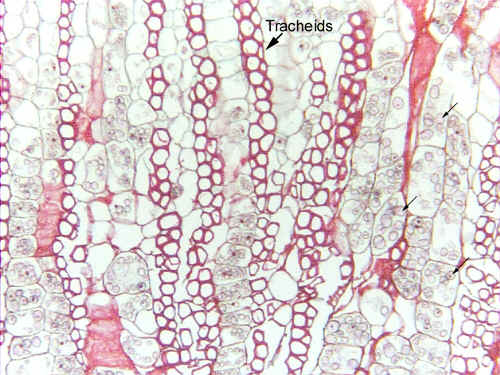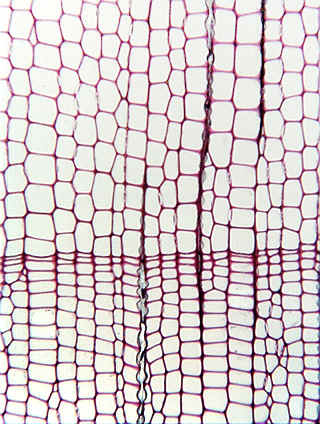Up
Intro: dicot wood
Intro: conifer wood
Intro: pine wood
Intro: annual rings
Pine tan s, ray
Pine xs, ray
Pine tan s, CBP
Pine rs, ray tracheids
Pine rs, ray
Fir rs, living rays
Manoxylic wood
Pine xs, CBP
CBP
Cambial record
Pine rs, tracheids
Dicot, primary ray
Living ray cells
Distorted rays
Uni-, multiseriate rays
Aggregate ray
Upright, procumbent cells
Sclerified ray
Cactus ray
Vessel radii
Solitary vessels
Clustered vessels
Vessels in chains
Ring, diffuse porous
Tyloses
Diffuse parenchyma
Banded parenchyma
Scanty paratracheal
Parenchymatous wood
Dimorphic wood 1
Dimorphic wood 2
| |
 Fig.
15.2-8a and b. Transverse section of wood of Zamia (called
“cardboard palm” – but Zamia is a gymnosperm, not a monocot).
Cycads like this Zamia in the upper micrograph have manoxylic
wood – wood high a high abundance of parenchyma. The rows of
tracheids are narrow, and the parenchyma cells are filled with starch grains
(small arrows). Fig.
15.2-8a and b. Transverse section of wood of Zamia (called
“cardboard palm” – but Zamia is a gymnosperm, not a monocot).
Cycads like this Zamia in the upper micrograph have manoxylic
wood – wood high a high abundance of parenchyma. The rows of
tracheids are narrow, and the parenchyma cells are filled with starch grains
(small arrows).
This
is very different from the pycnoxylic
wood of conifers, shown in the lower micrograph of pine, in which
parenchyma is rare and almost all the wood consists of axial tracheids.
|
 Fig.
15.2-8a and b. Transverse section of wood of Zamia (called
“cardboard palm” – but Zamia is a gymnosperm, not a monocot).
Cycads like this Zamia in the upper micrograph have manoxylic
wood – wood high a high abundance of parenchyma. The rows of
tracheids are narrow, and the parenchyma cells are filled with starch grains
(small arrows).
Fig.
15.2-8a and b. Transverse section of wood of Zamia (called
“cardboard palm” – but Zamia is a gymnosperm, not a monocot).
Cycads like this Zamia in the upper micrograph have manoxylic
wood – wood high a high abundance of parenchyma. The rows of
tracheids are narrow, and the parenchyma cells are filled with starch grains
(small arrows).